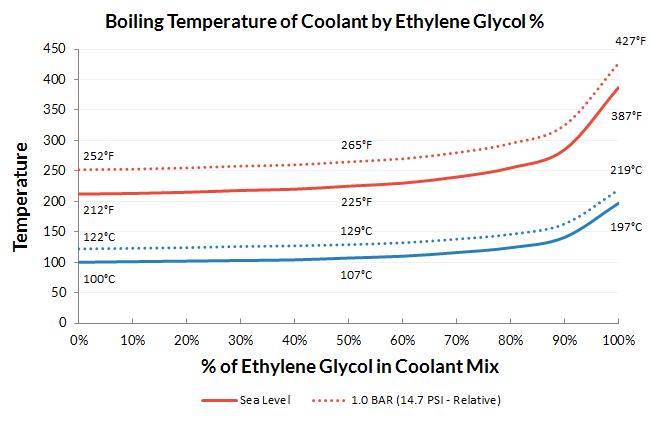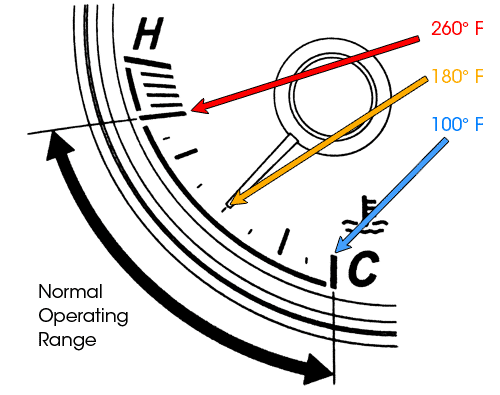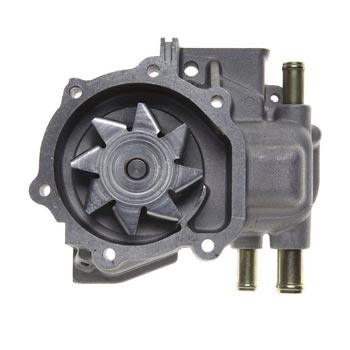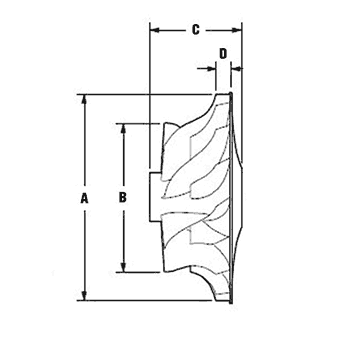

Learn to Diagnose, Fix, and Prevent Overheating
Click on the link(s) below to jump to that section of the article.
Cars tend to overheat at the most inopportune time. Typically you're stuck in traffic and the needle starts to rise, along with your blood pressure. It's no fun, but in most cases you can easily prevent your car from overheating the coolant.
The first thing to know is that the gauge in your car typically measures the temperature of the coolant, not the oil. Oil helps to also cool the engine, particularly the reciprocating parts within. The coolant, also referred to as antifreeze, mixture is 50% coolant and 50% water in most cases, with the coolant being a chemical called Ethylene Glycol, or EG for short. Outside of the US the antifreeze may also be Propylene Glycol, or PG for short, due to its improved ecological nature including a reduced toxicity to animals.

Ethylene Glycol, aka antifreeze, raises the boiling temperature of the coolant by 7% at a 50% mixture with water
Ethylene glycol, aka antifreeze, is added to the water to increase the boiling temperature of the coolant and to also reduce the freezing temperature. The typical mixture of antifreeze to water is 1:1, or 50% water and 50% antifreeze. In hard winter climates the antifreeze mixture may be 70% by volume.
Most cars want to run around 180°F to 200°F. This puts the engine in a sweet spot for fuel efficiency. This doesn't leave much room when you consider the normal boiling temperature of water at sea level is 212°F. That's why the cooling system is pressurized, and why you have a fancy radiator cap instead of a milk jug lid.

1 BAR (14.5 PSI / 100 kPa) of pressure increases the boiling temperature of the coolant by 18% at normal mixture ratios
The first thing to do is to turn on the heater full blast. The heater uses the coolant to warm the air, thus it will act like a small, second radiator and help to cool down the coolant. The air will be very warm, so on a warm day I recommend rolling down the windows to avoid suffering.
The second thing to do is to turn off the A/C. The A/C condenser is located in front of the radiator and will warm the incoming air, reducing the efficiency of the radiator.
Third, make sure you are maintaining awareness and traveling at a safe speed. Go ahead and move over to the exit or turn lane and look for a suitable place to stop. Avoid the side of the road, it's not a safe place to be, especially at night or with fast traffic. You'll want to also avoid hard acceleration as this can cause detonation and make overheating worse.
Lastly, go ahead and turn off the engine once you've stopped. If there is steam coming from underneath the hood, go ahead and leave the hood closed. There could be boiling coolant being sprayed through a blown hose, or another safety issue. Once it subsides, go ahead and pop the hood to let everything cool down faster.
It will take about 20 - 30 minutes for the engine to cool down on average. If it's cold outside, this will be closer to 10 - 15 minutes, and if it's a hot summer day, it could take an hour. You can speed this up by turning the ignition to the "ON" position (without starting the engine) if the vehicle has electric fans. I recommend letting the fans run for only a few minutes, they pull quite a bit of energy out of the battery.
There are a number of scenarios that typically occur. I will give the symptoms and try to explain the causality for each scenario, as each is indicative of specific issues.
Why does my Car Overheat Sitting in Traffic?
The most common cause of overheating at low speeds is the lack of airflow through the radiator. This can be due to radiator damage (high numbers of bent fins), but is most likely due to a faulty electric fan assembly, fan clutch, or fan switch. Also check to ensure the radiator is not obstructed by leaves or trash.
Car Overheating but the Coolant is Full?
Low coolant is only one reason why engines will overheat. Poor airflow, blocked passages, old hoses, bad radiator caps, blown headgaskets can all cause overheating. It's important to look at when the car overheats and inspect each component involved in that failure.
Why does my Car only Overheat on the Highway?
The biggest cause of this is a faulty thermostat that is stuck closed. A damaged radiator, low coolant, faulty radiator cap, or obstructed radiator can also be at fault. Check to make sure nothing is blocking your front bumper openings. If the radiator cap were to be at fault you most likely would see steam from boiling coolant.
Why does my Car only Overheat when I Accelerate Quickly or Drive Hard?
Assuming everything is in working order, this typically is because you have an undersized radiator for your application. Switch to an all-aluminum multi-core “racing” radiator from a quality maker, and if you live in a warmer climate go to a 70:30 mix of EG and distilled water.
Why does my Car Always Overheat?
This is a problem that can have a series of causalities, but the most typical problem is an obstruction in the interior core of the radiator, limiting its ability to cool and flow coolant. Another is a total lack of coolant, build up of scale / rust in the flow pathways due to improper maintenance, or a faulty temperature sender unit.
Just because the gauge says the engine is running hot, does not mean the gauge or its sender unit itself is not faulty.
Why does my Car Overheat Randomly, with No Pattern or Reason?
This kind of situation is really cut down to two things: air in the coolant system or a thermostat with a sense of humor. Typically you don’t get variable problems with other issues.
Why does my Car Overheat Quickly when I'm at a High RPM?
This can be the same issue as above, see: driven hard, but a special consideration is the radiator hoses. At high flow rates the low-pressure side of the water pump can cause the radiator hose to collapse, restricting flow. This is why it’s important to routinely test the hoses for compliance or go to a higher performance option.
The gauge does not work linearly in the vast majority of vehicles. Meaning, if the gauge moves 1mm it can be respective of 10° F, or it can account for a change of 40° F. This is due to how the coolant temp sensor operates, and also means that the gauge is not a very reliable measure of just how hot the engine is running. It could be a few degrees above a normal range or it could be ready to boil over.

As the coolant temperature rises the Engine Control Unit, the computer running your engine, begins to take measures to protect the engine. It will reduce ignition timing and increase the amount of fuel injected into the engine. Both of these measures will reduce the amount of heat generated by only a small amount, but are in place to primarily prevent detonation or knock from hammering the pistons, rods, bearings, and crankshaft to death.
The cooling system itself begins to pressurize due to the entire cooling system being sealed and the expanding coolant. This pressure aids in many ways. The first is increasing the boiling temperature of the coolant to prevent boil-off, and other benefits include increased nucleate boiling threshold to prevent overheating of internal surfaces, particularly the combustion chamber roof and exhaust ports. If those surfaces were to be superheated they would succumb to cracking or deformation along with causing run-away detonation inside the combustion chamber.
Within the cooling system the primary line of defense from overheating is the fan. The fan can be a large mechanical fan, or they can be electric fans mounted to the radiator. In the case of the mechanical fan, a thermally sensitive clutch engages when the warm air being pulled through the radiator heats it up. This drives the big fan and pulls a lot of airflow through the radiator. In the case of electrical fans they rely on information from the ECU on when to turn on and run. Typically once the coolant temperatures reach a certain point, say 210° F, the fans will begin to run until it cools down.
If the fan is unable to pull air through the radiator then the coolant temperatures will continue to rise. Typically at this point you are at a low speed or even at a stop. This means air is not being pushed through the radiator and it is unable to exchange the heat necessary to cool the coolant.
By now the temperature gauge on your dash will begin to creep up from it’s normal resting place. Since there is no way to pull heat out of the coolant the temperature will continue to increase. Initially the coolant will begin to boil off within the engine where heated surfaces are exchanging heat energy to the coolant. This promotes nucleate boiling which increases the rate of exchange, however with the coolant being unable to shed the heat via the radiator it will begin to create larger bubbles until it finally creates a vapor barrier between the hot metal surface and the coolant itself. From that point the engine will begin to knock heavily until the piston, rod bearing, or rod fails.
While that process is occurring internally the coolant in the radiator continues to expand, creating additional pressure. The radiator cap regulates the coolant system pressure; hence why they have a pressure measurement (in PSI or BAR) on the label. The pressure will continue to build until the radiator cap opens and allows the expanding coolant volume to bypass the radiator and fill the coolant overflow tank. The downside to this is that by reducing the amount of coolant volume in the system you are also effectively reducing the thermal energy capacity of the cooling system. This causes the temperature to rise quicker than before. Pressure also has a positive effect on water pump design, because it can prevent damaging cavitation at higher pump impeller speeds.
Ultimately if left to it’s own, this scenario would cause engine failure. Either the reciprocating mass (pistons, rods, crankshaft, etc.) would fail, or you would at least cause cracking in the cylinder head, causing additional issues. If coolant leaks through a headgasket or a cracked cylinder head into the combustion chamber in sufficient volume the engine will hydro-lock and at a bare minimum crush a connecting rod in a most spectacular fashion.
In short, don’t let your engine overheat to the point of mass failure.
An engine will run hot because of many reasons. Each involves it’s own specific fix, but with a little understanding of how the heat exchange system works will help you decide where your problem lies.
There are a couple of important elements to an automotive cooling system. They are the radiator, hoses, water jacket, water pump, overflow reservoir, and thermostat. The radiator is located at the front of the car and pulls heat energy out of the coolant. As airflow pushes through the fins of the radiator it takes with it the thermal energy.

Koyo Aluminum Racing Radiator
The radiator is connected with rubber or silicone hoses to the thermostat housing which holds the vitally important thermostat. The thermostat acts like a traffic light to regulate the operating temperature of the coolant. It remains closed when the coolant is too cool and opens to allow coolant to cycle through the radiator.

Coolant Thermostat
From there the coolant travels into the engine block, into what is referred to as the “water jacket”, an internal series of passages that direct the coolant through important heat exchange surfaces within the engine. Typically there will be a pair of silicone or rubber hoses that extend from the back of the engine into the passenger cabin to supply warm coolant to your heater core. Once out of the engine, the coolant travels back to the radiator, thus completing the heat exchange cycle.

Typical Water Pump
Your owners manual will have a maintenance schedule that covers when you should replace the coolant, belts, hoses, and other items. They are organized generally by mileage, i.e. "Replace the coolant every 60,000 miles." This is a good guideline to follow to avoid overheating issues due to worn or ageing components. Failure to replace these items on time can lead to additional failures, not just overheating.
Coolant, aka "anti-freeze", not only improves the operating temperature range, but it also contains anti-corrosion additives to prevent the build-up of rust within the engine. Rust will reduce the efficiency of the cooling system greatly by insulating the engine, restricting flow, causing water pump cavitation, and eventually blocking coolant passages in the engine, heater, and radiator. It's very important to replace the coolant on-time.
Only use DISTILLED water in a cooling system. Distilled water is pH neutral and free of minerals which can cause corrosion and scale.
It's extremely important that you use the proper coolant for your engine. The additives and chemical properties of coolant vary and must be matched to your vehicle to avoid overheating and prevent corrosion. Your vehicle manufacturer will let you know which coolant is suitable, but you can also double check that your vehicle is listed on aftermarket coolant jugs, usually on the front or back.
Coolant is often differentiated by it's color. Green, gold, orange, and blue are commonly used colors to visually differentiate the different formulations out there. It's not a hard rule that you need to use one color or another, there are exceptions. If in doubt, run the OEM coolant. The OEM coolant recommendations often will include engine-specific additive updates that are important. Subaru, for example, has an additive that helps to prevent headgasket failure in earlier EJ-series engines.
The key culprit in radiators are the plastic endtanks. It seems that they like to spring a leak between 80,000 - 100,000 miles (125,000 - 160,000 kms). That's why it's important to pre-emptively replace the radiator with a quality OEM or aftermarket radiator. Apart from OEM, I recommend sticking with top-tier aftermarket brands, whom often make the OEM radiators. I personally recommend Koyo for aftermarket replacement radiators.
Recommended Radiators for my Vehicle
Thermostats are a common cause of overheating for vehicles. To make matters worse, they can even fail intermittently. When they fail, they often restrict or outright block coolant flow between the engine and radiator. For this reason, you want to buy a very good thermostat. Typically, the OEM thermostat is best, but I've also used Stant.
Find a Thermostat for my Vehicle
Avoid cooler temp rated thermostats, especially in cold weather areas. They can reduce engine power and worsen fuel economy significantly.
Belts typically last 30,000 - 50,000 miles (45,000 - 80,000 kms) with shorter life spans in warm climate areas. A loose belt can slip or a worn belt can snap, both leading to overheating issues. If your belts are cracking or are excessively flimsy, it's time to replace them. I recommend Gates or Continental brand belts.
Recommended Belts for my Vehicle
Water pump failures are typically due to the pump bearings being worn. The excessive bearing play erodes the seal and it will begin to leak. Some water pumps actually have a drip hole that acts like a warning when this occurs. This is why it's also important to run the right amount of belt tension. Excessive belt tension will prematurely wear out the water pump bearing.
Water pumps are typically located on the front of the engine and are ran by the serpentine or accessory drive belt. However, some pumps are driven by the timing belt and are harder to get to such as on Hondas and Subarus.
Water pumps last between 60,000 - 90,000 miles (100,000 - 145,000 kms). I recommend replacing them at 60,000 - 75,000 miles to be on the safe side. Engines with a timing belt driven water pump should absolutely replace the water pump every time they replace the timing belt, without question. I recommend OEM (Motorcraft, Aisin, AC Delco, etc.), or Gates water pumps.
Recommended Water Pumps for my Vehicle
Hoses are simple, but they often cause overheating when they age. The water pump creates a good amount of suction, particularly at higher RPM, which can collapse or restrict an old rubber hose.
Recommended Radiator Hoses for my Vehicle
The radiator cap needs to maintain a certain amount of pressure to be effective. Occassionally they can leak or open prematurely which leads to a reduction in system pressure. This reduction in pressure can allow boiling to occur which reduces cooling ability. Routinely check the radiator cap for function when you replace the coolant or notice coolant spilling from the overflow. I recommend an OEM cap, or an aftermarket cap from a quality manufacturer.
Be sure the cap has at least the same pressure rating as the factory one. While a higher pressure cap is beneficial, it can cause significant problems if gaskets and seals or other cooling system components are incompatible.
Recommended Radiator Caps for my Vehicle
Get a Factory Service Manual and a good multimeter and temperature probe. Remove the coolant temp. sensor, clean any film off of it, and place the probe portion into a pot, half-filled with water, on the stove. Place the temp. probe for the meter into the pot and slowly start to warm the coolant. The manual will have a voltage range that the sensor will output, typically on a 5v scale. The voltage will correspond to the measured temperature. Double check that the voltages are correct at the temperatures in the manual.
It is very important for engine operation and fuel economy that the temperature sensor operates properly. It's a key sensor in the electronics.
If the engine or transmission are suffering issues, it often places a much larger load on the cooling system. Occassionally, overheating is the result of a mechanical issue.
There are a lot of aftermarket accessories like brush guards, horns, lights, bras, etc. that people often install on the front of the vehicle. Make sure they aren't obstructing the front bumper openings. These will significantly reduce cooling airflow.
Leaves, bags, dirt, birds, bugs, and all sorts of debris can block airflow through the radiator, intercooler(s), and other heat exchangers like the A/C condensor. Check the front bumper openings and make sure that they are clear of debris.
The plastic fender liners, undertray, shrouds, and cowls that originally came on your vehicle are there to direct airflow. The radiator, intercooler(s), and other heat exchangers rely on the proper flow of air to perform. On most vehicles, these have substantial effects on coolant temperatures, especially at speed. They also improve your fuel economy, A/C, and engine power output. Occassionally, you can modify liners for additional cooling flow, but this is very application limited.
You can get replacement guides and clips from your OEM dealer, local junkyard / auto recycler, or fabricate your own from sheet aluminum / plastic. Since these pieces are often large and expensive to ship, also look on local marketplaces like Facebook, Craigslist, etc.
Buy a bunch of these liner clips, they often are the culprit and are cheap: Bulk Plastic Clips
Preventing Subaru Ringland Failure in the WRX, STI, etc.
Subaru Equal vs. Unequal Length Headers
Detonation and Knock Explained | Causes and Prevention
We are constantly looking for new content ideas and feedback from the community. Head over to our contact page and send us an email with your ideas, comments, or questions.

Join our email list to be notified when we release new content.
We respect your inbox and send only 1 - 4 emails per month.
We will never spam, sell, or do annoying things with it ... ever.